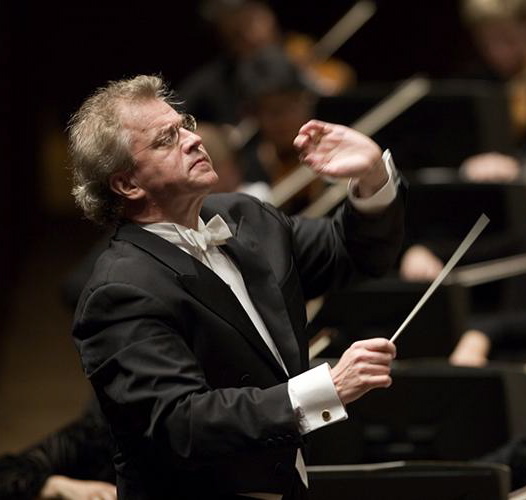Vänska, Minnesota Orchestra bring musical power, unique chemistry to Arsht Center

Osmo Vänska conducted the Minnesota Orchestra in music of Aho, Beethoven and Sibelius Tuesday night at the Arsht Center. File photo: Greg Helgeson
The Arsht Center classical series opened Tuesday night with an outstanding concert by the Minnesota Orchestra under music director Osmo Vänska. Contemporary Finnish music and the symphonies of Beethoven and Sibelius have become house specialties for the Minneapolis-based ensemble during Vänska’s tenure. A program that sampled each of these aptly demonstrated the special chemistry between this conductor and orchestra.
Kalevi Aho is one of Finland’s most prolific composers. He has written no less than 16 symphonies plus three chamber symphonies and numerous concertos, chamber music scores and operas.
Aho’s 20-minute tone poem Gejia was commissioned by the National Center for the Arts in Beijing and is strongly influenced by traditional Chinese folk music from Guizhou province. Unlike many Asian-tinged contemporary scores, Aho’s work is not travelogue music. He skillfully combines authentic native melodies with an aggressive modernist symphonic palette. The result is a striking portrait by an artist painting in 21st-century colors that occasionally frames ancient musical visions.
Aho’s score opens with an extended cadenza for three percussionists who play Chinese theater drums and gong in addition to more conventional instruments. Churning strings, a serene viola solo and lengthy flute roulades suggest mysticism interspersed amid fiercely dissonant climaxes.
The work was a fine showcase for the superbly drilled ensemble. Full-bodied string sonority, spiky brass chorales and agile percussion brought out the music’s relentless energy. The players turned on a dime in the sudden changes of meter and vast dynamic contrasts.
Vänska and the orchestra have made highly acclaimed recordings of the nine symphonies of Beethoven for the BIS label. The performance of the Symphony No. 1 in C Major vividly conveyed the idiomatic authority this conductor brings to that repertoire. This was one of the best Beethoven symphony performances heard in South Florida in recent seasons. Unlike many conductors, Vänska did not utilize reduced orchestral forces for this early Beethoven score. Eschewing chamber orchestra dimensions, he fielded a full string section but there was nothing heavy or weighted about the performance. All of the symphony’s Haydenesque humor came through.
There was a crisp sense of rhythm in the first movement with the wind solos deftly pointed. With first and second violins divided on each side of the podium and basses on the far left, the underlying pulse beneath the graceful melody of the Andante cantabile con moto was strongly present. Vänska brought out the timpani’s prominent role in a propulsive Scherzo. Those little string hesitations in the opening bars of the Allegro molto finale were expertly timed and Vänska infused the lively themes with vigor and wit while swaying back and forth on the podium. Exquisite playing from all sections contributed to this masterful realization of Beethoven’s initial symphonic essay.
From Sibelius’ friend Robert Kajanus (who made some of the earliest recordings of the composer’s music) to Tauno Hannikainen and Esa-Pekka Salonen, Finnish conductors have long displayed a special affinity for the works of their most famous compatriot. Vänska has recorded two complete cycles of Sibelius symphonies—with Finland’s Lahti Symphony and, more recently, with the Minnesotans.
His reading of the Symphony No. 5 in E-flat Major placed subtlety over bombast. Tempos were slower than the norm and climaxes were built in gradual layers. Vänska scaled the craggy peaks and valleys of Sibelius’ discourse with restraint and icy clarity and the performance was all the more effective for that.
The opening horn motif was beautifully balanced and tonally luminous. Vänska achieved pianissimos just short of inaudibility, the dynamics wonderfully differentiated. The Andante mosso, quasi allegretto was not played as a mere intermezzo but as a dramatic bridge with tragic undertones between the two more muscular movements. Wild differentiations of tempo brought fast sections taken at a very rapid clip while slower moments were spaciously delivered.
In the final movement, horns and basses rose through the orchestral textures with great eloquence as the secondary theme took prominence. Instead of punching out the conclusion, the trumpets gradually gathered momentum and volume over the sensuous strings (led by concertmaster Erin Keefe). The final six chords were firm and carefully spaced.
Vänska is scheduled to lead the New World Symphony on March 10 and 11 in a program that includes Sibelius’s Symphony No. 1. With his mastery and experience in this unique symphonic canon, that concert promises to be an event not to be missed.
The Arsht Center Classical Series continues with Christoph Eschenbach conducting the Bamberg Symphony in Mozart’s Overture to Don Giovanni, Beethoven’s Symphony No. 3 and Bruch’s Violin Concerto No. 1 with soloist Ray Chen 8 p.m. February 11. arshtcenter.org
Osmo Vänska conducts the New World Symphony in Sibelius’ Symphony No. 1 and Grieg’s Piano Concerto with soloist Garrick Ohlsson 7:30 p.m. March 10 at the New World Center and 8 p.m. March 11 at the Arsht Center. Nielsen’s Helios Overture will be played on the March 11 concert only. nws.edu; 305-673-3331.
Posted in Performances
Leave a Comment
Wed Jan 11, 2017
at 12:04 pm
No Comments